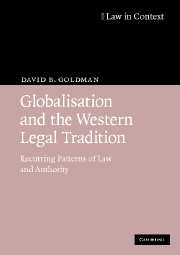Book contents
- Frontmatter
- Contents
- Preface
- 1 Introduction
- Part 1 Towards a Globalist Jurisprudence
- 2 Globalisation and the World Revolution
- 3 Law and authority in space and time
- Part 2 A Holy Roman Empire
- Part 3 State Formation and Reformation
- Part 4 A Wholly Mammon Empire?
- Part 5 Competing Jurisdictions Case Studies
- Bibliography
- Index
2 - Globalisation and the World Revolution
Published online by Cambridge University Press: 30 March 2010
- Frontmatter
- Contents
- Preface
- 1 Introduction
- Part 1 Towards a Globalist Jurisprudence
- 2 Globalisation and the World Revolution
- 3 Law and authority in space and time
- Part 2 A Holy Roman Empire
- Part 3 State Formation and Reformation
- Part 4 A Wholly Mammon Empire?
- Part 5 Competing Jurisdictions Case Studies
- Bibliography
- Index
Summary
Technology is a key element of globalisation. The effects of globalisation are frequently explored in the context of sovereignty. Technology therefore has constitutional implications. Perceived legal correlates to globalisation, such as the blurring divide between private and public international law through present constitutional issues associated with competing jurisdictions, legal pluralism, multinational enterprises and a ‘world society’, are related to the technological innovation associated with the World Revolution of the two world wars of the twentieth century. Yet it would be a mistake to assume that these legal developments are simple reactions to technological and economic forces of globalisation representing the latest political and economic goals. Far from today's legal responses being surface events, deeply layered sediments of legal and political philosophy and history underlie the topsoil intersections of law and globalisation. Globalisation and law cannot be understood without delving into the deeper sediments, pursued in later chapters. In this chapter, the topsoil formations are first surveyed in order to identify the sites of authority for later excavation.
The general notion of globalisation as ‘the accelerated interconnections amongst things that happen in the world’ will be maintained after some investigation. The terrorist events of ‘September 11’ 2001, in the United States, confirm this definition. (Within a fortnight, the world aviation industry was plunged into dire financial circumstances, international tourism reeled and the insurance industry faced massive losses.) After observing the profound associated challenges for social time and space in this chapter, a novel model will be proposed in chapter 3 to complete the outline for a globalist jurisprudence the subject of part 2.
- Type
- Chapter
- Information
- Globalisation and the Western Legal TraditionRecurring Patterns of Law and Authority, pp. 25 - 51Publisher: Cambridge University PressPrint publication year: 2008



